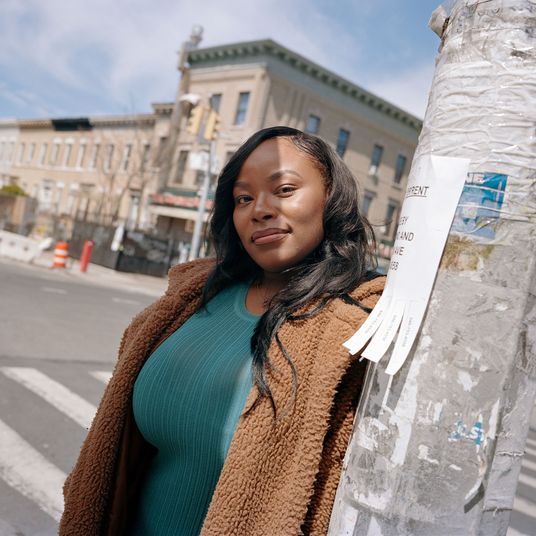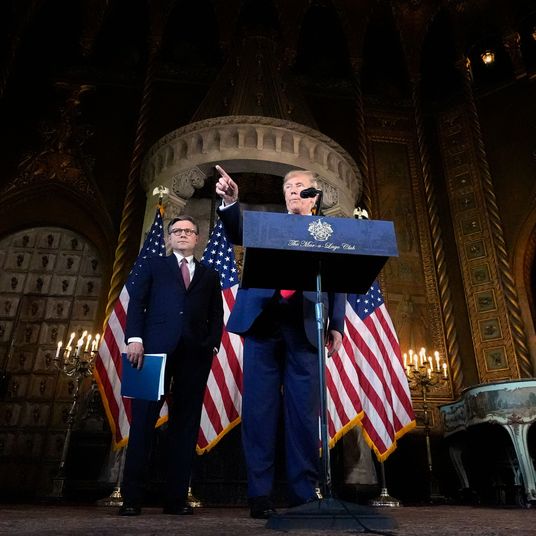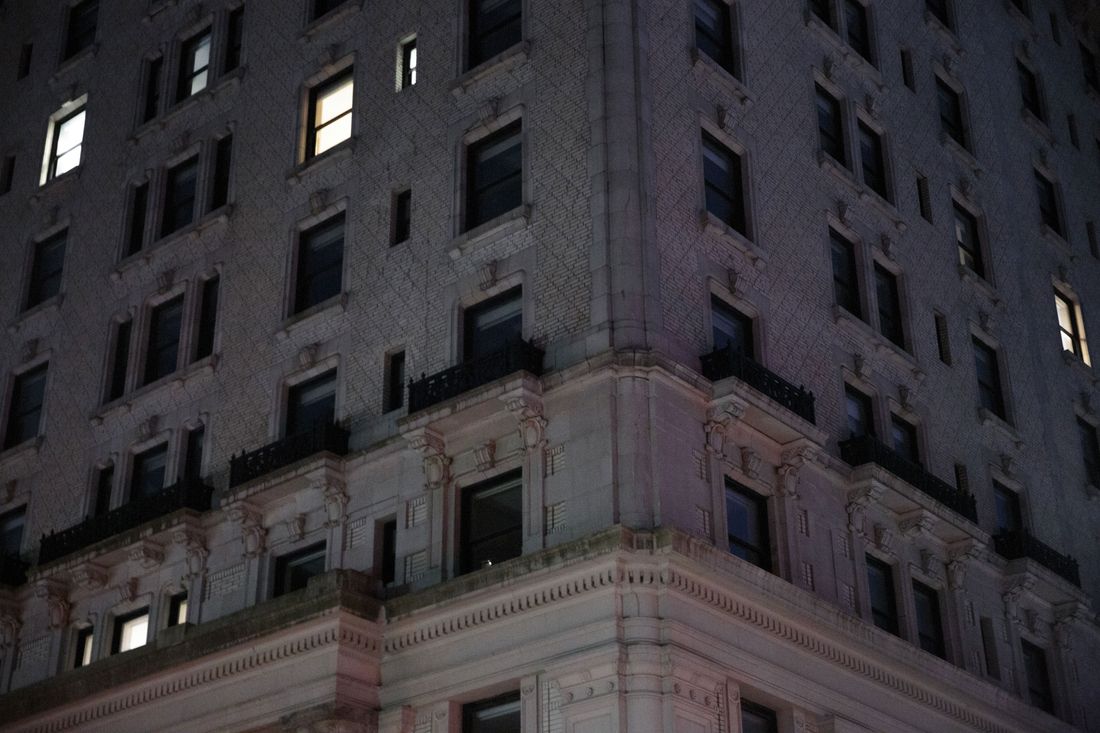
From the outside, the Hotel Bossert on Brooklyn Heights’s tree-lined Montague Street looks to be deserted. At night, its windows are mostly dark. Inside, the grand marble-and-tile lobby is empty apart from a lone security guard listening to the radio at a foldout table. Schmooze your way past him, take the elevator up a few floors, and pad down empty hallways lined with new carpeting and peer into the pristinely made up rooms, furnished with flat-screen TVs, mid-century-style sofas, and king-size beds with crisp white sheets, and that assumption will hold. But make your way up to the tenth floor of this 14-story historic hotel and you may encounter the smell of something frying, the clatter of silverware, and the squawk of a bird.
Follow the sounds and you’ll reach the apartment of 88-year-old Daisy Diamontopulos and her daughter, Elana, two of just five rent-stabilized tenants living in the otherwise empty, freshly renovated boutique hotel.
When I visited earlier this year, the pair turned out to be genial hosts, despite being in the middle of both dinner and the evening news. Daisy, a retired health-insurance worker, originally moved to the Bossert in 1967 with her husband. She pays about $700 a month for the two-bedroom apartment she shares with Elana, a high-school science teacher, and Adam, their electric-green talking Amazon parrot. (Adam has lived at the hotel since the ’70s, when Elana was just 4, making him almost 50.) The walls of their apartment are heavy with framed family photos; icons of Jesus, Mary & Co.; and ceramic Acropolis souvenir plates. Adam’s cage is by a window that has breathtaking views of New Jersey, Ellis Island, the Statue of Liberty, and lower Manhattan.
The Bossert was originally built in 1909 by a Williamsburg-based lumber magnate as a state-of-the-art accommodation for both transient and permanent guests. Back then, a brochure tempted would-be residents with promises of celebrity neighbors, proximity to Brooklyn’s steamships, double-filtered drinking water, and even an on-site nail salon. One of its biggest draws was its maritime-themed rooftop restaurant that resembled a two-tiered promenade deck of a ship, with 360-degree views of Brooklyn and Manhattan. “They used to call the hotel the Waldorf-Astoria of Brooklyn,” Elana informed me, taking out her phone to scroll through black-and-white photos from the Bossert’s golden age. The Dodgers hung out there, and when they beat the Yankees and won the World Series in 1955, they celebrated by drinking beer and singing to their manager under chandeliers in the Bossert’s lobby.
As with Brooklyn’s other grand hotel — the famed Hotel St. George — when the borough deteriorated in the ’60s, so did the Bossert. The rooftop restaurant closed, and the hotel started catering to single-room-occupancy tenants. It was, Elana explains, “very in and out. Sailors used to come and stay here when the naval yard was more active.” Local kids would sneak into the seedy lobby bar and drink with down-and-out residents. According to neighborhood gossip, in the early ’80s a teenage girl passed out in the snow after a night there (rumor was that she was drugged). But Daisy remembers the hotel’s less illustrious days fondly. “The manager was almost like a god, he was the nicest man, and we had characters here — ladies from Spain would all congregate in the lobby. It was glamorous. I’d never lived in a hotel before,” she says. “We even had housekeepers who changed their uniform three times a day.”
By the time the Jehovah’s Witnesses added Bossert to their expansive portfolio of Brooklyn real estate in the 1980s, the Bossert was in a state of disrepair. The religious group, which at one point owned about $1 billion worth of property in the area, including its world headquarters near the Brooklyn Bridge, intended to use the building to house headquarters staff. It turned out to be a good steward of the property: refortifying the deteriorated window frames with handcrafted mahogany, replacing 2,500 square feet of marble with Italian stone, and casting new plaster for the ceiling, which the group had hand-painted. (The Jehovah’s Witnesses earned at least two preservation awards for its efforts.) The group also promised not to evict any of the 180, mostly elderly, remaining tenants. It did, however, install a loudspeaker to deliver religious messages throughout the building. By the end of the ’80s, only 50 original tenants were left. In 2010, the Bossert was a hotel again — though one extremely popular with Jehovah’s Witnesses, who were allowed to check in for a few nights free.
“I loved my Jehovah’s Witnesses!” Daisy says. They brought a real sense of community to the hotel.
“In the beginning, they wanted to make you one of them, and we were like: ‘See all the crosses all over the apartment?’” says Elana. “‘We are Roman Catholic, let’s each stick to our own religion and get along.’ After that, they took us in like family, and we took them in, too.” Daisy regularly hosted parties for her Evangelical neighbors, and once when she had to be rushed to the hospital, the manager got one of his female staff to chaperone her. “When I got there, she was patiently sitting there with my mother by the X-ray machine,” recalls Elana.
They liked their apartment much better back then, too. “We had the best rubberized floor. It was perfect. You could mop it, you could sweep it; the Jehovah’s did that special for us before they left,” says Elana. Daisy agrees. “We had beautiful stuff like copper in the bathrooms. Every three years, they would come and knock on my door and say, ‘Mrs. Diamontopulos, it’s time to paint. What color do you want?’”
In 2012, as part of their larger retreat from Brooklyn real estate, the Jehovahs sold the Bossert to David Bistricer and Joseph Chetrit for $81 million. The new owners immediately announced plans to turn the building into a 280-room boutique hotel. According to Elana, the new owners offered them $30,000 to give up their apartment, but despite the looming renovations, they refused to budge. “We would have left, but where do you go? What can you afford?” says Elana. “Sometimes I panicked — me displaced, okay, fine, I can live in a box, but what am I going to do with my mom?”
Three others chose to stay put with Elana and Daisy: An elderly man lives below them on the eighth floor, and underneath him is Julian Cheung, who moved there as a student in 1981, when he had just arrived in New York from Hong Kong. The last holdout, Monica Grier, lives upstairs, on the 11th floor. After giving me a tour of the various views from the empty rooms on the tenth floor, Elana took me to meet her neighbor, whom she’s known since she was a kid.
A 91-year-old English expat, Monica had moved to the Bossert in the 1950s with her husband, a judge advocate for the U.S. Army, and their baby son. A friend recommended it as a good place for families. Monica also considered leaving when the hotel was sold, she says. “It’s a difficult move. My son and daughter-in-law are over in Manhattan, and that’s very expensive, so I said, ‘No. This is my home. I’ll sit here and see what happens, and then if it’s really hopeless, I’ll do something.’”
During the renovations, the owners moved the five holdouts (and Adam the parrot) to larger apartments on the 13th floor, where they stayed for about three years. “Oh, that was an apartment, we had two bathrooms!” says Daisy. Elana liked that it was easier to check on her elderly neighbors when they lived closer to each other. “We were all together while the banging and tearing apart was going on. It was nice and cozy.” They also had the company of the construction crew, who they agree were mostly well behaved, aside from occasional “horseplay” or wafts of marijuana smoke. At times Monica did worry they might secretly stay overnight in the empty rooms. “They were a bit of a rough lot,” she says.
When Daisy and Elana returned to their apartment, they were disappointed to find the walls had been rearranged. They are still angry about the new layout, which they say took from the living areas to make a larger bathroom. “I cried when I came back. It was ugly and smaller and there was no room for all of our stuff … They told me that the fridge was going in the living room — I said, ‘How can I open my bed out with that in there? Do you want me to put my feet in it?’” says Daisy, who sleeps on the living room’s foldout couch at night. They rearranged their furniture and moved dressers and shoe racks from the bedroom into the bathroom, which was too big for their liking. (Daisy: “You could skate in it! There were tiles all over the place. That’s when I said to Elana, ‘What are we going to do, live in it?’”) They paid for new sliding cupboard doors to save space.
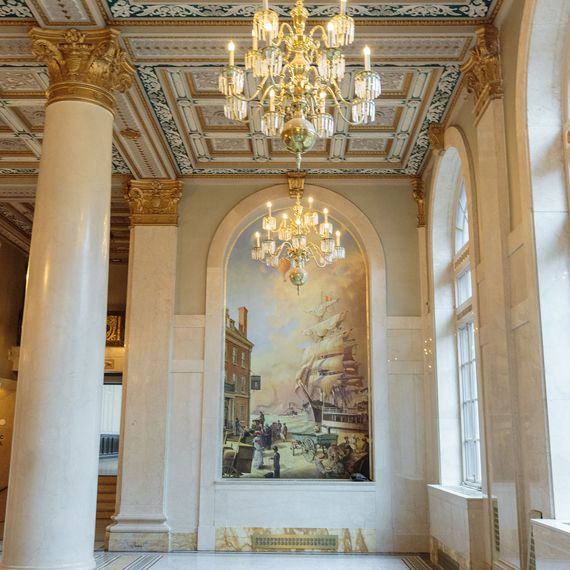
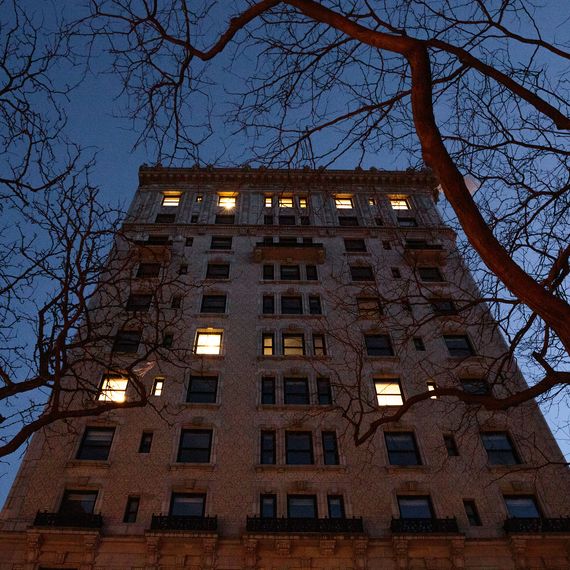
Because the building was a construction site for so long, the tenants have had to sacrifice some basic amenities like apartment buzzers, a front-door key (when Monica wants to get the security guard’s attention, she taps on the window with her wedding ring), phone lines, and cable. Both Daisy and Monica’s children have given them cell phones, which they hang from pouches on their walkers. “I told them that I need a house phone for my mother; she’s not in tune with this cell phone. She has to worry about charging it, and she holds it so tight she accidentally turns the volume off,” says Elana. (Monica also has a poor relationship with her flip phone: “I hate this thing with a deadly hatred.”)
Monica admits that in recent years, living at the Bossert has been a bit of an adventure. “Just after the sale, the new owners left a hole in the roof and it rained. That was quite an exciting night. It flooded my bathroom … I emptied a few buckets myself, then I realized, I have to get help.”
And yet things have mostly worked out well for Monica, who says the new owners have treated her carefully. Her only complaint is that the hot water is haphazard, but she loves her fancy bathroom — she even has lights above the bathtub. “You can light yourself up! Très sexy, right?” she says while giving me a tour.
All three women insist they feel safe — that security guard keeps watch in the lobby, the front door is bolted shut, and occasionally someone patrols the hallways. Still, life inside an empty hotel can get lonely, admits Elana, who sometimes creeps around at night turning off lights to save power and closing doors to the empty rooms to keep out any unauthorized guests: “We are like the people left behind … I’m not saying it’s miserable, but nobody seems to understand. You’re interacting with the world out there where time keeps moving — but in here, everything is freeze-framed. I suppose what it comes down to is when you are renters, you have to take what you can get.”
Monica agrees that it was a bit “spooky” alone on the 11th floor, but she’s comforted knowing that the other tenants are out there, even if they aren’t immediately next door. “You feel their presence,” she says. And any jitters are nothing on the ’60s and ’70s, when she’d hear women scream from the rooms next door and approaching the building could be treacherous. “I was more frightened back then than I am now,” she says.
After construction delays, as well as difficulty securing a management team and a recent split between the new owners (this spring, Chetrit bought out Bistricer), the Bossert is set to open in September, according to general manager Aliya Huey. Huey says the holdout tenants are as much a part of the hotel’s history as its diamond brickwork and lion’s-head keystones: “We embraced them. They are a part of the hotel.” Elana is adamant that, like all the other changes over the years, when the Bossert does finally open to paying guests, she’ll adapt. “We will live around them,” she says. “They will live around us.”




















